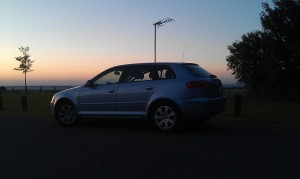The UK licence conditions seem fairly clear when it comes to the definitions of mobile and portable; however on deeper analysis it’s clear some degree of interpretation is needed. Following a recent heated (to put it mildly) debate on the dreaded Facebook, I thought this was a great opportunity to put my thoughts down in the form of a blog post.
Firstly, identification of portable (/p), mobile (/m) and alternative (/a) are now optional. However, when used, I believe we should use these in a consistent manner. From the Facebook discussion it was also obvious many amateurs have been using these terms incorrectly for years and were now passing on their misunderstandings to newly licensed operators.
Firstly, the current license states the following:-
Note point 2: “Mobile means Radio Equipment is located … on the person … where the Licensee is a pedestrian”.
Given the definition of Mobile, the licence then explains:-
It is clear that the long held belief (by some) that /p refers to ‘pedestrian mobile’ or use of ‘portable radios’ is incorrect. The older BR68 also contains similar wording; this is not a recent change * (note: see update below).
If a licensee is operating from an alternative (registered) address he/she signs /a (alternative). If a licensee is operating whilst mobile (in a vehicle OR on foot) he/she signs /m (mobile). If a licensee operates at a temporary location, he/she signs /p (portable).
Simple, right? Only, apparently it’s not. “So I’m mobile in a car, but what if I stop?” and “SOTA operations sign as portable even when using radios in backpacks, transported on foot”.
If you’re stationary with no plans to move whilst transmitting (for example parked up on a hill for the afternoon, or activating SOTA) then sign portable. If you have an intention to move whilst transmitting (in a vehicle or on foot) then sign mobile.
Update: G8ADD via MM0HAI’s blog states:-
"I have my first licence issued in 1964 put away so safely that I can't find it! This is from a re-issue in 1977: 9.(1)(b) at the temporary premises the suffix "/A" shall be added to the callsign. 9.(1)(c) at the temporary location or as a pedestrian the suffix "/P" shall be added to the callsign. 9.(1)(d) in or on a vehicle or vessel the suffix "/M" shall be added to the callsign. 9.(4) When the station is used at the temporary premises or location, the address of the temporary premises or location shall be sent at the beginning and end of the establishment of communication with each separate amateur station, or at intervals of 15 minutes, whichever is more frequent."
This is clearly where the confusion can be found. Does anyone know when these definitions were changed to reflect the modern usage?
Further update, Trevor M5AKA (via twitter):-
“I believe the removal of pedestrian from /P was in the … Edinburgh Gazette Issue 22479 30 December 1988” – Trevor M5AKA (click link to open, see page 1933 / page 11 of pdf)
Any further comments? If so I’d love to hear from you!





Thanks, Steve.
I’ve been wondering about this while listening to various QSOs recently. Thanks for clearing it up 🙂
I always understood the distinction between mobile and portable to be whether you*could* be mobile, not whether you were. So operating while parked in a lay by means you are still /M if you could drive away mid-over. Similarly a SOTA backpacker is /M. But if you have done anything to prevent yourself from moving off during a QSO (drive-on mast/throw an end-fed into a tree) then you are /P because you’d have to take it down before you could move away. 73
The use of /P to include Pedestrian operation dated back to the time when you needed to apply for a separate Mobile Licence in order to operate from a vehicle.
The definition of /P changed to just mean temporary location sometime between 1980 and 2002 but I don’t know when, but it’ll be somewhere in the London, Edinburgh and Belfast Gazettes where all changes to the amateur licence were announced. You can search online at https://www.thegazette.co.uk/
Thanks for the information – very much appreciated!
Pedestrian had been removed from /P by 30 December 1988, see Edinburgh Gazette Issue 22479 https://www.thegazette.co.uk/Edinburgh/issue/22479/data.pdf